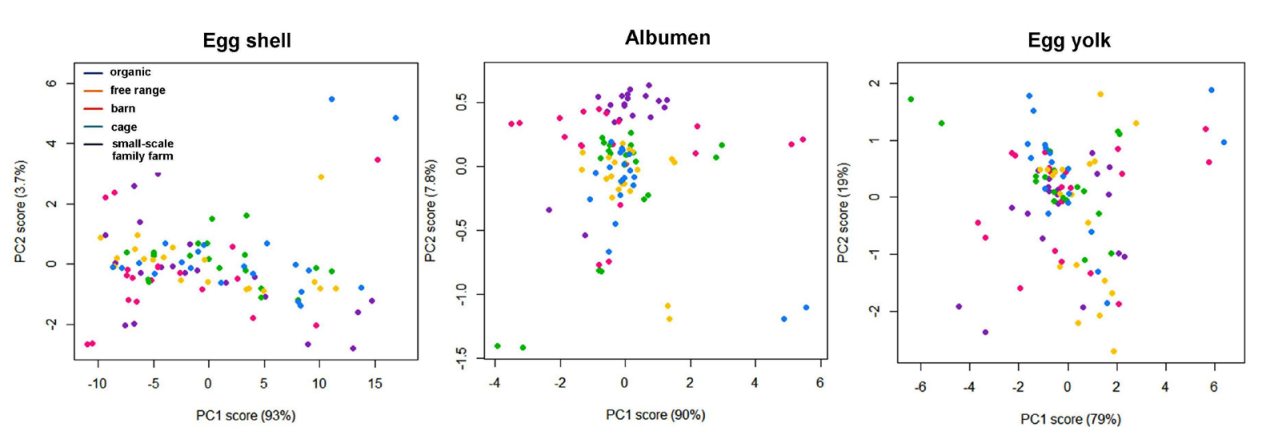Assessment of poultry eggs freshness using FTIR spectroscopy combined with HCA and PCA methods
DOI:
https://doi.org/10.5604/01.3001.0012.1414Keywords:
egg freshness, FTIR spectroscopy, chemometricsAbstract
The main aim of this study was to investigate the use of Attenuated Total Reflection Fourier Transform Infrared Spectroscopy (ATR FTIR) and selected chemometric methods to classify eggs in terms of the laying hen farming method, as well as to identify changes in the individual egg compositions during storage. In total, 50 eggs were used for the study; 10 eggs per classes: 0, 1, 2, 3 and rural. Eggs were stored by 29 days period, which was divided on the 10 measuring days in which one egg from each class was tested by recording two FTIR spectra for the shell, albumen and egg yolk. The chemometric analysis, including Hierarchical Cluster Analysis (HCA) and the Principal Component Analysis (PCA), was performed based on the recorded FTIR spectra. Changes in chemical composition during the experiment in individual egg elements were analyzed. Furthermore, by analyzing the graphs (HCA and PCA) obtained by the chemometric analysis, it was noted that the largest changes in the chemical composition of eggs occurred in the shell and yolk, while in the albumen it was less insignificant. The chemometric analysis of the recorded spectra also showed that combination of chemometric methods and FTIR spectroscopy can potentially be used to develop a non-destructive method for classifying eggs in terms of the hen culture method and to monitor of their freshness.
Downloads
References
Rodríguez-Navarro AB, Dominiguez-Gasca N, Muñoz A, Ortega-Huertas M. Change in chicken eggshell cuticle with age and egg freshness, Poultry Science, 2013, 92, 3026–3035. Google Scholar
Karoui R, Kemps B, Bamelis F, de Ketelaere B, Decuypere E, de Baerdemaeker J. Methods to evaluate egg freshness in research and industry: A review, European Food Research and Technology, 2006, 222, 727–732. Google Scholar
Giunchi A, Berardinelli A, Ragni L, Fabbri A, Silaghi FA. Non-destructive freshness assessment of shell eggs using FT-NIR spectroscopy, Journal of Food Engineering, 2008, 89, 142–148. Google Scholar
Abdel-Nour N, Ngadi M, Prasher S, Karimi Y, Prediction of Egg Freshness and Albumen Quality Using Visible/Near Infrared Spectroscopy, Food and Bioprocess Technology, 2011, 4, 731–736. Google Scholar
Menges F, Spectragryph – optical spectroscopy software, Version 1.0.7, 2017, http://www.effemm2.de/spectragryph/ Google Scholar
R. Core Team (2017). R: A language and environment for statistical computing. R Foundation for Statistical Computing, Vienna, Austria. URL https://www.R-project.org/. Google Scholar
Hanson BA. ChemoSpec: Exploratory Chemometricsfor Spectroscopy, 2016. R package version 4.4.x. Google Scholar
https://webbook.nist.gov/cgi/cbook.cgi?ID=C7732185&Type=IR-SPEC&Index=1 Google Scholar
Barth A. Infrared spectroscopy of proteins, Biochimica et Biophysica Acta – Bioenergetic, 2007, 9, 1073–1101. Google Scholar

Downloads
Published
How to Cite
Issue
Section
License
Copyright (c) 2018 University of Applied Sciences in Tarnow, Poland & Authors

This work is licensed under a Creative Commons Attribution-NonCommercial 4.0 International License.



